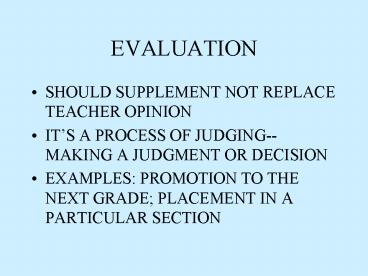EVALUATION - PowerPoint PPT Presentation
1 / 31
Title:
EVALUATION
Description:
MORE ENCOMPASSING THAN MEASUREMENT OR TESTING ... Novice..Apprentice..Proficient..Distinguished. Numeric 1----5. Criteria Components. Content ... – PowerPoint PPT presentation
Number of Views:103
Avg rating:3.0/5.0
Title: EVALUATION
1
EVALUATION
- SHOULD SUPPLEMENT NOT REPLACE TEACHER OPINION
- ITS A PROCESS OF JUDGING--MAKING A JUDGMENT OR
DECISION - EXAMPLES PROMOTION TO THE NEXT GRADE PLACEMENT
IN A PARTICULAR SECTION
2
EVALUATION (CONT.)
- MORE ENCOMPASSING THAN MEASUREMENT OR TESTING
- Formative Evaluation-- analysis during the
learning process. To assess improvement - Summative Evaluation--describes the level of
achievement at the close of marking period,
semester or year.
3
- Evaluation should be continuous throughout the
learning process not just at the end.
4
MEASUREMENT
- USED TO DETERMINE THE AMOUNT OF ATTRIBUTE
POSSESSED - EXAMPLES READING COMPREHENSION PROBLEM SOLVING
SKILL INTEREST IN A SPECIFIC CAREER
5
TESTING
- INSTRUMENTS USED TO SAMPLE THE ATTRIBUTE TRAIT.
- COULD USE DIFFERENT TESTS FOR THE SAME ATTRIBUTE.
6
A Test Should
- Discriminate--- It should separate those who know
from those who dont know. - Note it is a sample of the information learned.
So we want a good sample.
7
Test Purposes
- 1. Selection-- used to accept or reject
- Driving test.
- Readiness for kindergarten
8
Placement
- Prediction of success
- Putting into groups
- Examples reading groups, math groups
9
Diagnosis
- Used to determine strengths or weaknesses
10
Feedback
- Used to determine mastery, achievement, or norm
relationship - Examples
- Maine Education Assessment tests
- Teacher made tests
11
Motivation Guidance
- Used to direct or encourage learning
12
Program Curriculum
- To determine progress and improvement in a
program or curriculum
13
Tests should be
- Valid
- Validity-- measures what it is supposed to
measure. - On target
- Fair
14
- Reliable (reliability) -- is consistent in
results in similar situations and with similar
students. - Increase reliability by longer tests and more
homogeneous content.
15
Objectivity
- Refers to scoring
- Will separate scorers get similar results
16
Helpful hints
- Test items should relate to objectives
- Items should show various levels of difficulty
- Easier item first
- Group similar types of items together
- Use several types of test items
17
Helpful hints (cont.)
- Enough time to finish the test
- Plan for those who finish early
- Give clear directions for each section
- Plan ahead for easy scoring
18
- No test item is perfect--no matter how much time
and consideration it receives
19
Evaluation Tools
- Observation
- Anecdotal Records
- Questionnaires
- Tests
- Self Reports
- Inventories
- Attitude Scales
20
- Projects
- Portfolios
21
Rubrics
- Used to avoid vague assessment criteria of
student work - Authentic Assessment-- assessing real world
experience - Students can assist in the design of rubrics for
their work
22
Advantages of Rubrics
- Assessment is more objective and consistent
- Teacher clarifies criteria
- Shows students how work will be evaluated and
what is expected. - Aids with peer appraisal of performance
- Feedback for instruction
- Gives benchmarks for progress in learning
23
Features of Rubrics
- Focus on objective
- Uses a range to rate performance
- Shows degree to which a standard is met
24
Rubric Development Steps
- 1. Determine learning outcomes
- 2. Brief statements or phrases (4-15)
- 3. Each rubric for a different skill
- 4. Focus on how students develop express
learning. - 5.Evaluate only measureable criteria
- 6. One sheet of paper for a rubric.
25
- 7. Reevaluate the rubric (Did it Work)
26
Range /Scoring Levels
- Needs improvement..satisfactoryGoodExemplary
- BeginningDevelopingAccomplishedExemplary
- Novice..Apprentice..Proficient..Distinguished
- Numeric 1----5
27
Criteria Components
- Content
- form and style
- quality and development of ideas
- organization, relevance
- wording and phrasing
- spelling, handwriting, neatness
- measurements
28
Components (cont.)
- Workmanship
- strength of product
- finish
- design
29
Words that convey degrees of performance
- Depth..Breath..Quality..Scope..Extent..Complexity.
.DegreesAccuracy - Presence to absence
- Complete to incomplete
- Manysomenone
- Major.minor
- Frequency alwaysgenerallyrarely
30
Learning Sequence
- Goals
- Activities
- Evaluation
31
Rubrics --web sites
- Http//edweb.sdsu.edu/webquest/rubrics/weblessons.
htm































